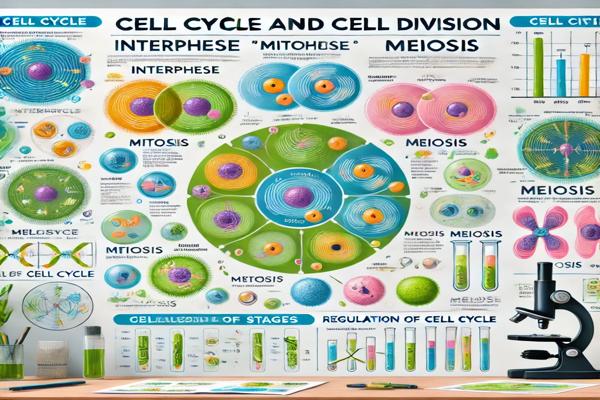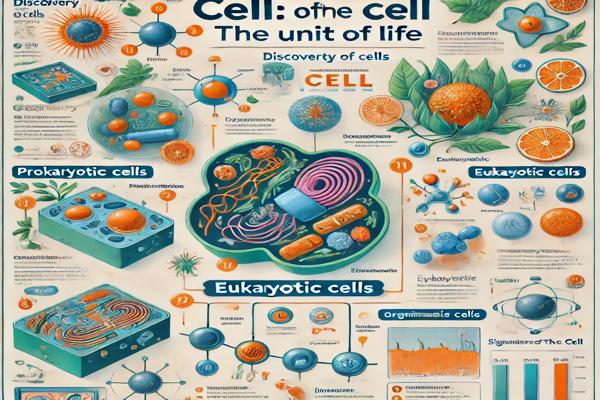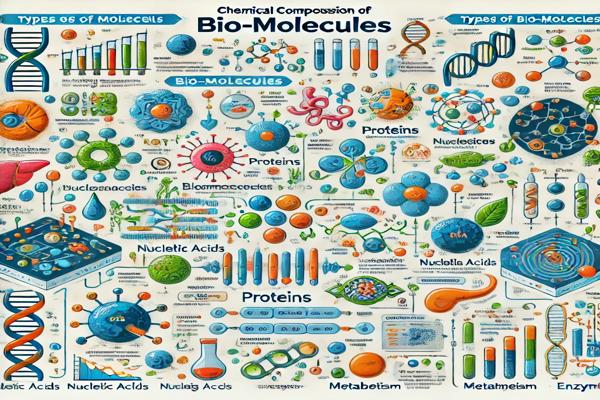Cell Cycle and Cell Division

The cell cycle and cell division are fundamental processes in the life of a cell. These processes ensure the growth, development, and reproduction of organisms by producing new cells. The cell cycle refers to a series of events that take place in a cell, leading to the formation of two daughter cells from a single parent cell.
Phases of the Cell Cycle
The cell cycle is divided into two main phases: Interphase and the M Phase (Mitosis phase).
1. Interphase
Interphase is the longest phase of the cell cycle, during which the cell prepares for division by growing and replicating its DNA. It is further divided into the following stages:
- G1 Phase (Gap 1): The cell grows in size, synthesizes proteins, and prepares the DNA for replication.
- S Phase (Synthesis Phase): DNA replication occurs, doubling the DNA content while maintaining the same chromosome number.
- G2 Phase (Gap 2): The cell undergoes further growth, synthesizes proteins required for mitosis, and ensures all organelles are prepared for division.
- G0 Phase (Quiescent Phase): A stage where metabolically active cells stop dividing and remain in a resting state for extended periods.
2. M Phase (Mitotic Phase)
The M Phase consists of two main events:
- Karyokinesis: Division of the nucleus.
- Cytokinesis: Division of the cytoplasm.
Mitosis
Mitosis is a process of cell division where the chromosomes are equally distributed between two daughter cells, maintaining the parental chromosome number. It is also known as equational division and typically occurs in somatic cells.
Stages of Mitosis
- Prophase:
- Chromosomes condense and become visible.
- The nucleolus and nuclear membrane disappear.
- Spindle fibers begin to form.
- Metaphase:
- Chromosomes align at the equatorial plate.
- Spindle fibers attach to the kinetochores of the chromosomes.
- Anaphase:
- Centromeres split, and sister chromatids are pulled to opposite poles by spindle fibers.
- Telophase:
- Chromatids reach their respective poles.
- Nuclear membrane and nucleolus reappear.
- Chromosomes decondense back into chromatin.
Cytokinesis
- In Animal Cells: Achieved through cleavage, forming a furrow that deepens until the cell splits into two.
- In Plant Cells: Achieved by the formation of a cell plate, which develops into a new cell wall.
When cytokinesis does not follow karyokinesis, a multinucleated condition called syncytium arises.
Significance of Mitosis
- Maintains the chromosome number in daughter cells.
- Facilitates growth and development of multicellular organisms.
- Replaces worn-out cells and repairs tissues.
- Ensures the maintenance of the nucleo-cytoplasmic ratio.
- Enables vegetative reproduction in plants.
Meiosis
Meiosis is a specialized type of cell division that reduces the chromosome number by half, resulting in the formation of haploid cells. It occurs in germ cells and is essential for sexual reproduction.
Meiosis consists of two successive divisions: Meiosis I and Meiosis II, with only one round of DNA replication.
Meiosis I
- Prophase I: This is a complex stage with five sub-stages:
- Leptotene: Chromosomes condense and become visible.
- Zygotene: Homologous chromosomes pair up in a process called synapsis, forming bivalents or tetrads.
- Pachytene: Non-sister chromatids exchange genetic material through crossing over, leading to genetic variation.
- Diplotene: Homologous chromosomes start separating, remaining attached at chiasmata (points of crossing over).
- Diakinesis: Chiasmata move to the chromosome ends. The nuclear envelope and nucleolus disintegrate.
- Metaphase I:
- Bivalents align at the metaphase plate.
- Spindle fibers attach to the centromeres of homologous chromosomes.
- Anaphase I:
- Homologous chromosomes are separated and pulled to opposite poles, while sister chromatids remain attached.
- Telophase I:
- Chromosomes reach the poles, and nuclear membranes may reform. This is followed by cytokinesis, resulting in two haploid cells.
Inter-kinesis: A short resting phase between Meiosis I and Meiosis II.
Meiosis II
- Prophase II:
- Chromosomes condense again.
- Nuclear envelope disappears, and spindle fibers form.
- Metaphase II:
- Chromosomes align at the equatorial plate.
- Kinetochores of sister chromatids attach to spindle fibers.
- Anaphase II:
- Centromeres split, and sister chromatids move to opposite poles.
- Telophase II:
- Chromosomes reach the poles.
- Nuclear envelopes and nucleoli reappear.
- Cytokinesis follows, resulting in four haploid cells.
Significance of Meiosis
- Reduces the chromosome number by half, maintaining the stability of the species’ genome across generations.
- Promotes genetic variation through crossing over and independent assortment.
- Facilitates evolution by introducing diversity in populations.
Differences Between Mitosis and Meiosis
| Feature | Mitosis | Meiosis |
|---|---|---|
| Type of Cells | Somatic cells | Germ cells |
| Number of Divisions | One | Two |
| Chromosome Number | Maintained (diploid) | Halved (haploid) |
| Genetic Variation | No variation | Introduces variation |
| Purpose | Growth, repair, asexual reproduction | Formation of gametes |
The Cell Cycle and Its Regulation
The cell cycle is tightly regulated by molecular mechanisms involving proteins and enzymes. Checkpoints ensure that errors are minimized:
- G1 Checkpoint: Ensures the cell is ready for DNA synthesis.
- G2 Checkpoint: Verifies that DNA replication is complete and accurate.
- M Checkpoint: Confirms proper spindle attachment to chromosomes before anaphase.
Cyclins and cyclin-dependent kinases (CDKs) are key regulators of the cell cycle. Their interaction ensures the timely progression of the cycle.
Conclusion
Understanding the cell cycle and cell division is crucial for comprehending how organisms grow, develop, and reproduce. The interplay between mitosis and meiosis ensures continuity of life while promoting diversity. These processes highlight the intricate balance of growth, repair, and reproduction, which are fundamental to all living organisms.
Keywords: Cell Cycle and Cell Division, Mitosis, Meiosis, Interphase, Karyokinesis, Cytokinesis, Prophase, Metaphase, Anaphase, Telophase, Genetic Variation, Cell Regulation.
Read also
- NCERT Official Textbook
- Cell Cycle and Cell Division – BYJU’S
- Cell Cycle and Cell Division – Toppr
- NCERT Solutions – Learn CBSE
- Cell Cycle and Cell Division – Vedantu
- ExamFear Notes on Cell Cycle
Hi, I’m Hamid Ali, an MSc in Biotechnology and a passionate Lecturer of Biology with over 11 years of teaching experience. I have dedicated my career to making complex biological concepts accessible and engaging for students and readers alike.
Beyond the classroom, I’m an avid blogger, sharing insights, educational resources, and my love for science to inspire lifelong learning. When I’m not teaching or writing, I enjoy exploring new advancements in biotechnology and contributing to meaningful discussions in the scientific community.
Thank you for visiting my blog! Feel free to connect and explore more of my work.





